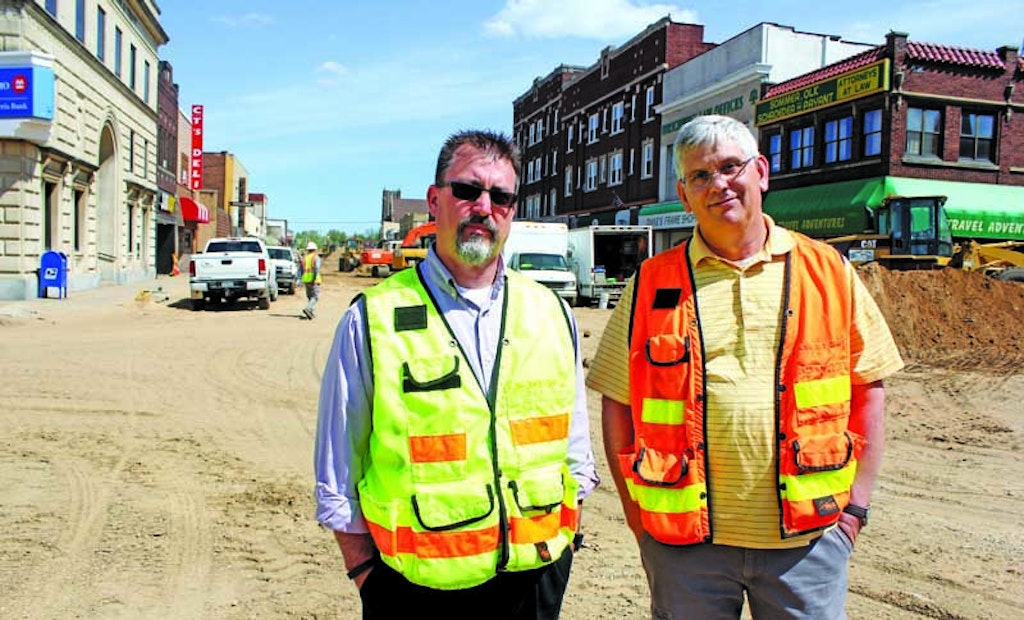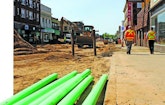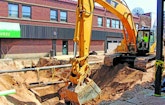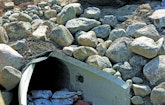
Interested in Rehab/Relining?
Get Rehab/Relining articles, news and videos right in your inbox! Sign up now.
Rehab/Relining + Get AlertsWhen you’re digging up streets that haven’t been dug up for decades, surprises are sure to emerge. The Northern Wisconsin city of Rhinelander is finding that out as it moves through a large sewer, water and streetscape project.
“We come across surprises every day in this construction,” says Tim Kingman, director of public works. “We’ve encountered some interesting foundation walls that are frightening, but we have to deal with them. We’ve encountered piping and abandoned materials that we didn’t know were there, some active materials we didn’t even know were there. It’s been revealing.”
The city, located about 2 1/2 hours northwest of Green Bay, has also had to deal with the challenges of keeping its downtown businesses operating as usual during the project. Keeping the sidewalks open for pedestrian traffic and keeping one of the two main streets open at all times are just some of the challenges the general contractor faces.
“The project has to be managed in a fashion where we keep our businesses open,” Kingman says. “There’s only two major thoroughfares north and south that we can work with, and having coordination of when one is open and the other is closed is really important.”
Separation anxiety
The project has been a long time coming for the community of 7,500, after smoke testing revealed some issues back in 2003.
“We knew there was an issue with the combined sewer years ago,” says Mark Barden, project engineer for Town & Country Engineering, which is overseeing the project. “We started smoke testing the downtown area to identify some of those issues. Then a couple years ago we got in and did some physical inspections of all the basements.”
Crews spent time mapping out the known infrastructure, the location of suspected roof drain connections, identifying any galvanized pipes and anything else that could be upgraded or improved. One of the main focuses of the project was taking care of the roof drains and storm sewer system.
About 30 of the 128 buildings downtown had roof drains that were connected to the sanitary sewer, creating issues at the wastewater treatment plant during rain events. “The main objective here was to separate the sanitary sewer and the storm sewer systems,” Barden says.
When a rain event would happen, the treatment plant would go from its average of 1 mgd to 3 or 4 mgd. “Whatever came off those roofs would be carried over to the treatment plant,” Kingman says. “After this project, we’re going to see a substantial difference on a rainy day.”
Increased capacity
The new infrastructure is being built to handle a 10-year storm event, Kingman says. The $9 million project broke ground in late March with the general contractor, Kruczek Construction of Green Bay, installing two new outfalls for the stormwater that will flow into the nearby Wisconsin River.
Prior to the project, there was just one 24-inch outfall that handled stormwater from the street surface. “That outfall covered the entire downtown area, which we knew wouldn’t be enough when we separated the combined sewer,” Barden says. “The 24-inch outfall is remaining, but we have now added a 36-inch outfall and a 42-inch outfall along the river.”
The first section of the project — a one-block stretch leading from the Wisconsin River to the first intersection — was the most difficult. “We have storm sewer on both sides of the road, just off the curb in that area,” Barden says. “There’s a couple reasons for that, such as taking advantage of the additional outfall and the other utilities in that area such as electric, gas and phone.”
The new storm sewer is being installed deeper than what it normally would be due to the harsh winter conditions at the top of Wisconsin. Businesses were connected to the stormwater system as crews worked their way through the middle of the city. “We’re actually coring into the foundation walls of all these businesses and we’re supplying the property owners with the connection to the storm sewer,” Barden says.
The city is paying to core through the walls, but once the pipes are inside the buildings, it becomes the property owner’s responsibility to get a private plumber to make those connections.
“When the project is done, we’re going to have everything separated,” Barden says. “The private plumber has been working pretty hard and they’re keeping up. They’re making those connections as we stub out those storm laterals and the water connections, so things are going pretty smooth so far.”
Barden says crews have upsized a lot of the water mains and a few of the sanitary sewer lines. “We’ve ran into some 4- and 6-inch water mains that we’re upsizing to 8-inch,” he says.
“We’ve also bumped up some 8-inch sanitary lines to 10-inch lines.”
Following the completion of the underground work in October, the city will move into its streetscape phase, where they will realign parking in the main business corridor and widen the sidewalks.
Planning the project
While the general contractor worked on the water and sewer infrastructure, other utilities took the opportunity to upgrade their own systems with the road torn up.
“The local gas utility is moving its lines and upgrading some of the older lines, while Frontier Communications is moving its ductwork for phone and internet,” Barden says. “You really have the benefit of working on all of it at the same time, and that’s the way we planned it.”
A project of this scope required years of planning and continued communication after the start of construction. The city held several planning meetings with residents to get input on the project and thoughts on a final design. “We’ve been very public about our approach and it’s paid tenfold,” Kingman says. “Without the cooperation of the property owners we would be dead in our tracks.
“The early public meetings were about how we would take care of the utilities and how we finish out the streets. This is a utilities-based project, but we also got into streetscape and we wanted to rejuvenate the area the best we could.”
Because of the location of the project and the importance of keeping businesses open, Kruczek Construction has had to make adjustments during the project — such as keeping sidewalks open and setting up temporary sidewalks, making sure at least one of the two main thoroughfares through downtown is open at all times and helping pedestrians navigate the streets.
Sewer bypass lines were installed right at the start, and the water system has been updated and reconnected one building at a time as the project progresses.
“The downtown has been in such disrepair,” Barden says. “Business owners see the value moving forward and I think a lot of these owners are looking forward to the future. We’ve been very active in keeping people up to date on the city’s website, we’re keeping the parking lots open for the customers. We’re trying to keep everything we can open for the businesses.”
Finding surprises
Kingman says the pavement on Brown Street, the downtown’s main street, hasn’t been torn up since the early 1980s. Its unknown when the water and sewer and other utilities were last worked on.
Early on in the project, Kruczek Construction and engineers began finding known and unknown mysteries — wood ductwork for electrical utilities, and basements under sidewalks, as examples.
“What is interesting is a lot of these building have basements that extend out into the right-of-way under the sidewalk. We’ve identified what we think is all of them and we’re abandoning them as we go along,” Barden says.
When digging near a bank building — about 100 years old — crews discovered windows under the sidewalk that allowed sunlight into the basement of the bank many years ago. Crews have had to fix those areas while continuing to work on the main project.
Crews are also removing the wood ductwork, which is located throughout the downtown area. The 4-by-4 posts were laid end to end horizontally with 3-inch channels bored through them for telephone and electrical lines. The posts are typically 8 to 10 feet long and connect together like Legos.
Set for the future
While most of the underground work is scheduled for completion by October 31, Barden says the final layer of asphalt won’t go down until summer 2017, to allow for any repairs or settling that might occur.
“When you start at the beginning again like we are doing, you can make it the way you want it,” Kingman says. “We’re getting this set up for the future right now.”
Part of a bigger picture
The water and sewer utility work taking place in Rhinelander, Wisconsin, is possible because of system updates the city has done over the past 10 years.
“In the last 10 years, the city probably has done more work than it has in the last 50 years,” says director of public works Tim Kingman. “We’re at that vintage of system where we have a lot of clay tile pipe. We have a lot of 4-inch cast mains that need to be replaced.”
The water utility owns and operates five drilled wells, three above-ground storage tanks, a 1.25 million gallon underground treatment reservoir, and more than 66 miles of distribution water mains ranging from 4- to 16-inch diameter in size. The utility supplies approximately 1.5 million gallons of potable drinking water to its customers on an average day.
Most of the projects in the last 10 years have been wastewater focused.
The city built a new wastewater treatment plant that went online in 2010, along with a new pipeline along the Wisconsin River to carry wastewater to the new plant.
“All of this came in the beginning from identifying excessive I&I occurring in the city,” Kingman says.
Another project that kicked off this summer in the city was connecting one of Rhinelander’s biggest industrial businesses to the wastewater treatment plant.
“This is a unique project taking place,” Kingman says of all the work. “A lot of communities might be able to learn or observe some patterns that we’ve done here.”











